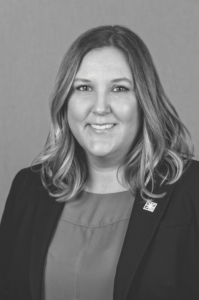At the Naples Airport Authority, an employee distracted by stress or anxiety could literally mean the difference between life and death.
“Being an airport, our No. 1 focus is safety,” says Virginia Bendle, director of human resources for the NAA. “When employees are stressed or have something going on that’s causing a mental health issue, then safety becomes a really big factor for us.”
Employees dealing with depression, anxiety and other mental health issues at work can become less productive or distracted. That’s not great in any workplace, but at the NAA, it might cause someone to overlook a needed maintenance issue on an aircraft, or miscalculate an element of a takeoff or landing.
That’s why the NAA includes an employee assistance plan among its benefits, through which employees can access counseling and other resources. Because of all the extra stressors everyone is dealing with these days, the NAA recently expanded the number of visits available to employees from three to five, and also entered into an informal partnership with a local mental health practice to ensure employees have easy and quick access to professional help when needed.
“Employees appreciate their employers when they know their employer cares about them in all aspects of their well-being,” says Bendle. “And when employees appreciate their employer, they stay at their jobs and are more productive.”
If you’re a business that hasn’t thought much about your employees and their mental health before, you probably have today. The COVID-19 pandemic and the fallout it’s caused in multiple areas of our lives (think financial stress, childcare problems, etc.) is causing an uptick in stress and anxiety, and companies are probably feeling that within their workplaces or among their staff.
According to a report from the Centers for Disease Control and Prevention, surveys conducted at the end of June found that almost 41% of U.S. adult respondents reported at least one adverse mental or behavioral health condition, including symptoms of anxiety disorder, depressive disorder or trauma- and stressor-related disorder or increased substance use to cope with stress or other emotions caused by COVID-19. More than 25% of respondents ages 18 to 24 and almost 22% of essential workers who responded said they had seriously considered suicide in the 30 days before completing the survey.
“I think there is an enormous amount of grief across the country,” says Paul Simeone, Ph.D ., vice president and medical director of behavioral and mental health for Lee Health. “People are mourning the loss of everything that was before the pandemic, and they’re not managing it well. We’re struggling, I think, as a region, and certainly as a country.”

Courtney Whitt, Ph.D.
Workplace Impacts
When personal struggles with issues such as depression and anxiety make their way into the workplace, it can lead to all kinds of problems. “People might start to make more mistakes or be more forgetful,” says Courtney Whitt, Ph.D., director of behavioral health at Healthcare Network, a private not-for-profit organization that provides primary medical and dental care in Collier County. “They could start calling out a lot, or perhaps their processing rate or performance goes down. There could be a change in team morale; an employee who is more pessimistic, withdrawn or on edge could impact collegial or customer interactions.”
A 2019 study from the World Health Organization found that depression and anxiety disorders cost the global economy $1 trillion a year in lost productivity. “Even if a person has low-level depression or anxiety, it’s going to affect their work, because it kind of clouds everything you do and think,” says Pam Baker, CEO of NAMI (National Alliance on Mental Illness) Collier County, which provides education, support and advocacy programs for people in the area with mental illnesses.
There are also bottom-line health care costs to consider. “Generally speaking, anyone who has depression, anxiety or a trauma disorder is three times more likely to be hospitalized than someone who just has high blood pressure,” says Philip Cirrone, COO of Elite DNA Therapy Services, a mental health provider with locations throughout Southwest Florida. “The comorbidities are extremely expensive. Whether you’re an employer who just expects your employees to show up to work and be happy, or you’re a big employer who has self-insured medical benefits, these employees are more costly.”

David Hall
If an employee has to step away from a job because of mental health issues, especially a highly valued employee, there’s a price there, too. “The cost of turnover is huge,” says David Carleton Hall, executive vice president, CFO and COO of Sanibel Captiva Community Bank. “Training new employees and getting them to follow how you want your business managed and run takes a lot of time and effort.”
The employee benefits package at the bank includes an 800 number that employees can call for counseling services. And from its founding, the bank has fostered a culture wherein employees feel supported and empowered. “That to us is hugely important, that our employees are rewarded, complemented and supported in what they do,” says Hall. “I think that a healthy employee is a much better employee. They’re much more productive and create more value for themselves and for the bank.”
And feeling valued makes employees want to stick around. “Employers that take care of their people don’t have the level of churn that other places have,” says Lee Health’s Simeone.
Bendle estimated that NAA’s mental health-related benefits for its almost 90 employees only cost about $10,000 a year. “It’s relatively inexpensive for a midsized organization,” she says. “And I’d say it’s invaluable, because how do you measure a nonevent or a person’s well-being?”
 Ways to Help
Ways to Help
The extra challenges brought on by the COVID-19 pandemic have caused many companies to take a new look at their employees’ mental health. Statistics released by Gartner in June show that 68% of organizations introduced at least one new wellness benefit by late March 2020 because of the COVID-19 pandemic. And it found that even before the pandemic, companies were allocating 45% of budget increases for well-being benefits toward programs focused on mental and emotional health.
At Pathways Early Education Center of Immokalee, staff and leadership went through toxic-stress training in advance of the preschool’s planned late August reopening. “It was not only to help the teachers themselves but also to teach them how to recognize what toxic stress is, how it affects children, how to identify it and what are some of the things we can do,” says Beth Hatch, the school’s executive director.
Financial institutions such as Sanibel Captiva Community Bank already have insight on why it’s so vital to help employees through trying times. “I hate to say it, but banks get robbed,” says Hall. “For our front-line employees, it’s really important for us to support them should that happen,
so they can talk it through and get some professional help to support them after those types of events.”
Companies need to play their part in removing the stigma that still surrounds mental health. “It’s perfectly OK to say, ‘I broke my leg,’” says Cirrone. “But if someone has depression or anxiety and is really struggling, they may feel like they can’t talk about it. It’s not as OK to say you’re depressed; people still look at it as [if ] you look weak.”
“Businesses need to take a stance that mental health is health,” says Whitt. “Taking a mental health day off should be fair game, just as it would be to take a sick day for the flu.”
Having flexible policies around working from home can be an easy way for businesses to support their employees’ mental health, and it’s something most companies have gotten a lot of experience with during the pandemic. More than half the staff at NAMI Collier County have diagnosed mental illnesses themselves, and that kind of flexibility is important for their well-being.
“They can come to the office if they want to, and if they don’t want to or feel that they shouldn’t for health reasons, there’s no pressure or applied preference,” says Baker. “That way people don’t feel guilty by choosing to stay home if that’s what feels safe.”
When coming up with company policies involving mental health, engage your staff in the process and be receptive when they come to you about an issue. “Listen to the concerns of your employees,” says Petra Jones, executive director at the Mental Health Association of Southwest Florida, which advocates for mental health support in the region. “Make sure employees feel comfortable enough to voice the concerns or problems they might have.” Hatch involved her staff in the reopening plans at Pathways Early Education Center. “Getting their input was a big part of it,” she says. “This is new for all of us; there isn’t a book that says ‘This is what we’re supposed to do.’ Making the staff part of the decision process has really helped. They are all returning to work and feel comfortable. I think it’s just building that relationship and trust.”
At Lee Health, Simeone and other senior staff members regularly check in with employees and share their own struggles in dealing with the current situation. “A lot of people are not going to come forward unless there’s some modeling by senior executives that this is OK to do,” he says. “I’m not saying you have to bleed all over the floor, but I am saying to normalize their feelings and validate what people are sharing.”
Companies can also provide employees with assessment and screening tools, and initiate efforts such as daily meditation sessions to inspire mental self-care.
“Encourage breaks to disconnect or recharge,” says Whitt. “Mental health concerns do not discriminate. They can impact us all, so we cannot not make it a priority. Even if right now you’re just concerned with the logistics of keeping the doors open and your business running, you can’t do that without thinking about your employees’ mental health.”
 2020 BURNOUT
2020 BURNOUT
A national polling of the U.S. workforce in August indicates 58% of employees are burned out, up from 45% in April.
The online survey of more than 1,000 respondents in a random sampling of employees nationwide was conducted April 8-10 and Aug. 13-17 by Eagle Hill Consulting. The focus was on COVID-19 and its potential impact on people’s work environment. Among the employees who reported burnout in the latter polling, 35% said it was due to circumstances from COVID-19, which is up from 25% in April.
Respondents’ claims for burnout:
47%—workload
39%—work/life balance
37%—lack of communication, feedback and support 30%—time pressures and lack of clarity around expectations
28%—performance expectations
Melissa Jezior, president and CEO of Eagle Hill Consulting, said this level of burnout is not only problematic but could increase as millions of employees continue to work from home and schools remain unable to fully open. “We’re in this pandemic for the long haul, and employers have got to find a way to make workloads sustainable for employees and better equip managers to lead,” she says. “Otherwise, companies risk harming their bottom line and brand.”
Source: 2020 Eagle Hill Consulting COVID-19 Employee Burnout Survey





